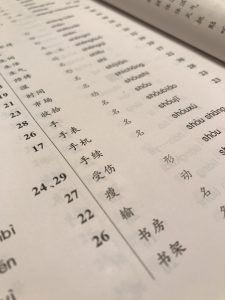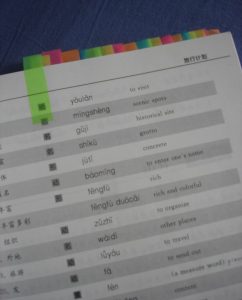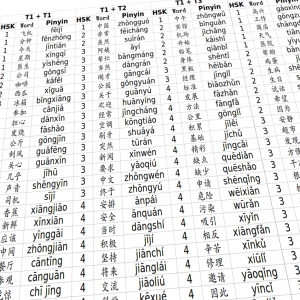 In recent article, I discussed pros and cons with using vocabulary lists to learn Chinese. The conclusion was that while it seems good to learn characters and words from lists, most students rely on lists too much.
In recent article, I discussed pros and cons with using vocabulary lists to learn Chinese. The conclusion was that while it seems good to learn characters and words from lists, most students rely on lists too much.
Let’s not throw out the baby with the bathwater, though, because lists can be genuinely useful when learning Chinese. In this follow-up article, I’d like to continue the discussion and get a little bit more practical, looking at specific kinds of lists to see how they can be useful.
Tune in to the Hacking Chinese Podcast to listen to the related episode:
Available on Apple Podcasts, Google Podcasts, Overcast, Spotify, YouTube and many other platforms!
If you haven’t read or listened to the previous article yet, I strongly recommend that you do so before proceeding with this one. Otherwise, you might get the impression that I think students should use lists more often, which is not the case. What I’m talking about here are specific cases, not advice about learning Chinese in general.
Five types of vocabulary lists that can help you learn Chinese
In this article, I will discuss five types of lists:
- Frequency lists
- Textbook vocabulary lists
- Proficiency test lists
- Special purpose lists
- Semantic and thematic lists
That’s quite a lot for one article, so let’s get started!
Chinese frequency lists: The most common characters and words
You might have heard that 80% of normal language use is made up of only 20 % of the words (or some variation of this). To illustrate what you can achieve if you know the right words, I wrote an article about this using only the 1000 most common words in English.
Many readers didn’t even notice.
While this shows that you can express complex ideas fluently using only a thousand words, it doesn’t mean that you will be able to write a text like this if you know only a thousand words. There are many reasons why you shouldn’t take a list of the most frequent words in Chinese and start working your way through it, most of which I covered in the previous article.
However, there are some cases where I think using frequency lists can be helpful, but this assumes that you find the right frequency list. In general, you should pick a list that mirrors what you want to use the language for as closely as possible.
- Do you want to improve your formal, written Chinese? Then a standard frequency list will work.
- Do you want to improve your informal, written Chinese? Then try a list based on online blogs and text messaging.
- Do you want to improve your spoken Chinese? Well, there aren’t many good frequency lists because collecting naturally spoken language is so much harder than hoovering up written text, but a list based on movie subtitles might be a decent alternative.
I have written about the most common Chinese words, characters and components for language learners and teachers here:
The most common Chinese words, characters and components for language learners and teachers
How should you use frequency lists to learn Chinese?
As I’ve already said both in this and the previous article, you normally shouldn’t learn words directly from a frequency list. This is a bit like memorising dictionaries, which can be useful, but is rarely a clever idea. So how should you use them, then?
Here are a few examples:
- To plug holes in your vocabulary – To put it briefly, frequency lists can be used to identify high-frequency words you might have missed. One way of doing this is to check for unknown words that are at least twice as common as other words you are learning. For example, if you know 1,000 characters in Chinese, checking the top 500 for something you have missed can be useful. I once did this with the most common 3,000 characters, which I’ve written about here.
- To determine which characters and words to learn – Obviously, I don’t mean that you should learn the words from the list, but if you’re reading digitally, which is a great idea, you might have access to frequency data at the touch of a button. If you look up a character or a word when reading, you can quickly move on if you noticed its low frequency compared to other words. However, if this information is not easy to access, you’re better off relying on frequency in your reading and listening material (i.e., if you see it often, learn it; if not, skip it).
Vocabulary lists for Chinese textbooks: The most useful characters and words
 How do textbook vocabulary lists compare to frequency lists? It depends on the textbook, especially the level of the textbook.
How do textbook vocabulary lists compare to frequency lists? It depends on the textbook, especially the level of the textbook.
A good textbook contains the most useful for the students in the target group. This is not the same as the most frequent words in the language, of course, because words like “Chinese”, “airport” and “toilet” are of comparatively low frequency in the general language, but essential for beginners.
Textbook authors do of course consult frequency lists, but they also use their own judgement and experience to determine what kind of texts students would benefit from, and thus which words they need to learn. In some cases, it’s the opposite, meaning that a text is written to cover certain words.
Chinese textbooks don’t always contain the most useful words
Sadly, all textbooks I’ve tried so far fall short when it comes to providing the most useful language for the students. They all contain words that are neither useful nor high frequency, put some incredibly useful words late in a beginner textbook, and so on. Naturally, if texts are written primarily to be relevant and engaging for the students, there will be occasional words that are necessary to tell a story, but which otherwise aren’t all that useful, but this is not what I’m talking about here.
Sometimes, I suspect textbook authors include rare words for no other reason than to annoy the students! On a more serious note, I think it’s the result of native speakers having a bad grasp of what is useful for student and how long it takes to learn a word. Learning characters for specific Chinese dishes, idioms with precise meaning or just randomly including formal language are good examples Textbooks also cram in way too many words per text, but that’s a topic for another time.
As was the case for frequency lists, textbook word lists become less and less useful as the chapters go by. The first book often does contain mostly words that are both high-frequency and useful (you can’t go wrong with basic nouns and verbs), but the vocabulary lists in book five in the same series looks random, mixing extremely high-frequency words that have been missed earlier with literary expressions.
This is part of the reason I recommend you to use more than one textbook instead of progressing too far in a certain series. This also avoids the illusion of advanced learning, i.e. when you finish the fifth book in a series, which will teach you some fancy expressions, but you still can’t speak fluently about everyday life.
Chinese proficiency test lists, a good balance between frequency and usefulness?
The two major proficiency tests for Chinese, HSK (Mainland) and TOCFL (Taiwan) both publish lists of vocabulary they recommend you to be familiar with when taking the test at various levels. These lists fall somewhere in between textbook lists and frequency lists.
- Link to official HSK 3.0 word lists (also see The new HSK 3.0: What you need to know)
- Link to TOCFL word lists (check the left-hand column)
These lists are like textbook lists in that they are curated with a second language learner in mind, which is great! They are like frequency lists in that they aren’t based on a specific text or story, and are thus less likely to contain words that are only important in that context.
However, this type of list has the same problems as the other types mentioned in that they become much less useful the further you progress. While you can learn everything in the HSK 1-2 lists and be certain that it will all be worthwhile, that’s not true for the higher levels, which are more akin to actual frequency lists.
How to use lists from Chinese proficiency tests properly
You can apply the same thinking to these lists as to frequency lists, so if your vocabulary knowledge is at HSK 4, then learn words from the HSK 2 list you don’t already know (there won’t be many). You could look at HSK 3 too, but you should not learn words from the HSK 4 list. If you’re interested in HSK specifically, you’re in luck, because I’ve already done most of the work for you here: What important words are missing from HSK? I also did the same analysis for TOCFL here.
It’s worth noting that these tests are just test, not roadmaps to follow when learning Chinese. As I argued in the article preceding this one, many students spend too much time with lists, and this is especially true for HSK lists. If you think HSK is a good roadmap for learning Chinese, think again!
In summary, proficiency lists at lower levels do combine usefulness and frequency in a useful way. This doesn’t mean you should base your entire approach around these lists, but they are the most useful lists if you want guidance for what words and characters are the most important to learn first.
Special purpose lists for learning Chinese
There are many lists created with a specific purpose in mind, such as:
- My list introducing the most commonly used 100 radicals
- My list with common vocabulary sorted by tone combination
- My list of vocabulary for playing and watching StarCraft in Chinese
- A list of phonetic components in Chinese characters
These are generally not lists that you learn words from, but can be very handy as a reference, especially when looking something up yourself is not trivial. While everybody could in theory sort all the HSK words by tone pair on their own, this requires basic programming knowledge and some time. When it comes to words for very niche topics, such as computer games, these words might not be listed in standard dictionaries at all.
You can learn words from special purpose lists if you think they would serve as a useful steppingstone to comprehension. For example, it can be very daunting to watch a StarCraft match with Chinese commentary the first time, even if you’re an advanced learner and know the game well. Going through a list of game-specific vocabulary beforehand makes it easier.
Similarly, it can be good to learn the most common components of Chinese characters just because it will help you immensely with learning other characters later. You could equally well achieve this by breaking down characters you encounter and looking up components that occur frequently, of course, but if you’re worried about learning less useful components, a list such as mine can be helpful.
When you use lists like these, you must understand that they are only indirectly boosting your proficiency. For example, learning components of characters doesn’t help your reading and writing ability much, but it does make it easier to learn characters you encounter while reading. Learning characters has a bigger impact on your reading ability, but it’s only one of the components needed!
This is why you should get most of your words from engaging with and using the language, not lists.
Semantic and thematic lists
There are two main approaches to grouping and introducing vocabulary: semantic and thematic. Organising vocabulary semantically means that similar words are introduced together, such as having one chapter teaching all the colours, another chapter containing all the basic items of clothing, and a third where you learn the days of the week.
Organising vocabulary thematically means that words are introduced based on the context they appear in, not what the words mean. In such a textbook chapter, someone might shop for a blue pair of shoes on a Monday, so you learn these words in the context of this story. In the next chapter, it’s Tuesday and the person with the blue shoes meets someone with a red shirt, and so on.
Words should be learnt in context, so that’s already a huge advantage of thematic vocabulary lists, but that doesn’t mean that semantic lists are useless.
- Use semantic lists to consolidate what you already know – Once you know most of the colours, go ahead and find a list of colours to make sure you’ve learnt them and so that you can sort out any misunderstandings. This is useful for trickier words, too, so once you’ve learnt 会/會 (huì) , 能 (néng) and 可以 (kěyǐ) for “can”, feel free to study them together and learn the differences.
- Use thematic lists for everything else – This shouldn’t come as a surprise, but since vocabulary learning is best done when embedded in context, thematic lists are the way to go. You can build these on your own based on your listening and reading, or use lists created by others, such as for textbooks, graded readers or other types of content.
Another example of a thematic lists would be those derived from the adventure text games for Chinese learners I’ve created with Kevin over at WordSwing. They contain vocabulary from the narrative in the game. You could use such lists to review what you have learnt in the game, or to preview in order to make playing easier.
Conclusion
As we saw in the previous article, vocabulary shouldn’t normally be learnt from lists. However, as we have seen here, there are some cases where using lists can be useful, if you know what you’re doing. If you think lists should be avoided at all costs, I hope that I have convinced you that they can sometimes be useful. If you focus a lot on lists, I hope you were convinced by the previous article that this is rarely good.
How do you use lists? Are there any types of lists I’ve left out here that you find useful? Are there any specific lists you’ve relied on and want to recommend to others? Please leave a comment below!
References and further reading
Folse, K. S. (2004). Myths about teaching and learning second language vocabulary: What recent research says. TESL reporter, 37, 13-13.
Gholami, J., & Khezrlou, S. (2014). Semantic and Thematic List Learning of Second Language Vocabulary. CATESOL Journal, 25(1), 151-162.
Nation, P. (2000). Learning vocabulary in lexical sets: Dangers and guidelines.
Papathanasiou, E. (2009). An investigation of two ways of presenting vocabulary. ELT journal, 63(4), 313-322.
Schmitt, N. (2008). Instructed second language vocabulary learning. Language teaching research, 12(3), 329-363.
Webb, S., & Nation, P. (2017). How vocabulary is learned. Oxford University Press.


5 comments
Thanks Olle for another great and useful article.
Currently, I have my own list which grows day by day. My daily process is like using my LinuxOS with a Chinese language setup and chatting with people via the HelloTalk app. This combination alone gave me a great boost in the last 3 weeks. Sure there is always Anki and Skritter aside all of that. 🙂
Regards,
Samuel
Excellent. The voice of experience and common sense. Many thanks.
I do appreciate because the chinese language is beautiful.
That’s a Great list of Chinese Vocabulary. I need to Do hard work to learn Chinese. Thanks For this Great post.
The one textbook I know of that does this well – picking words that are useful and/or high-frequency – is John DeFrancis’s Beginning Chinese Reader (and Intermediate and Advanced Chinese Readers). He explicitly introduced characters based on their frequency (e.g. the top 400 characters are introduced in Beginning Chinese Reader), and then useful words based on those characters. Really well done – the problem is that it’s so old that the vocabulary is quite out of date.